Early Childhood Studies Case Study: Child Safety Concerns
VerifiedAdded on 2022/10/09
|10
|2642
|15
Case Study
AI Summary
This case study examines a scenario involving a mother, Julie, and her child, Robbie, where the child is exposed to domestic violence perpetrated by the husband. The case highlights the concerns of child safety officers and explores the mother's reluctance to leave the abusive relationship. The essay critically analyzes the situation, considering the impact of domestic violence and alcoholism on the child's well-being. It explores multiple perspectives, including the mother's perspective, and challenges personal feelings about the case. The discussion delves into the prevalence of domestic violence, its roots in societal norms, and the reasons women stay in abusive relationships. The essay addresses the child's exposure to violence, the potential for child removal, and the impact of parental separation. It explores various theoretical frameworks, including attachment theory, family systems theory, and cognitive development theories, to understand the effects of trauma and family instability on the child's cognitive, social, and emotional development. The essay also discusses the importance of trauma-centered parenting and providing support to the victim. Finally, the essay proposes recommendations for supporting the mother and the child, including safety planning, referral services, and counseling.
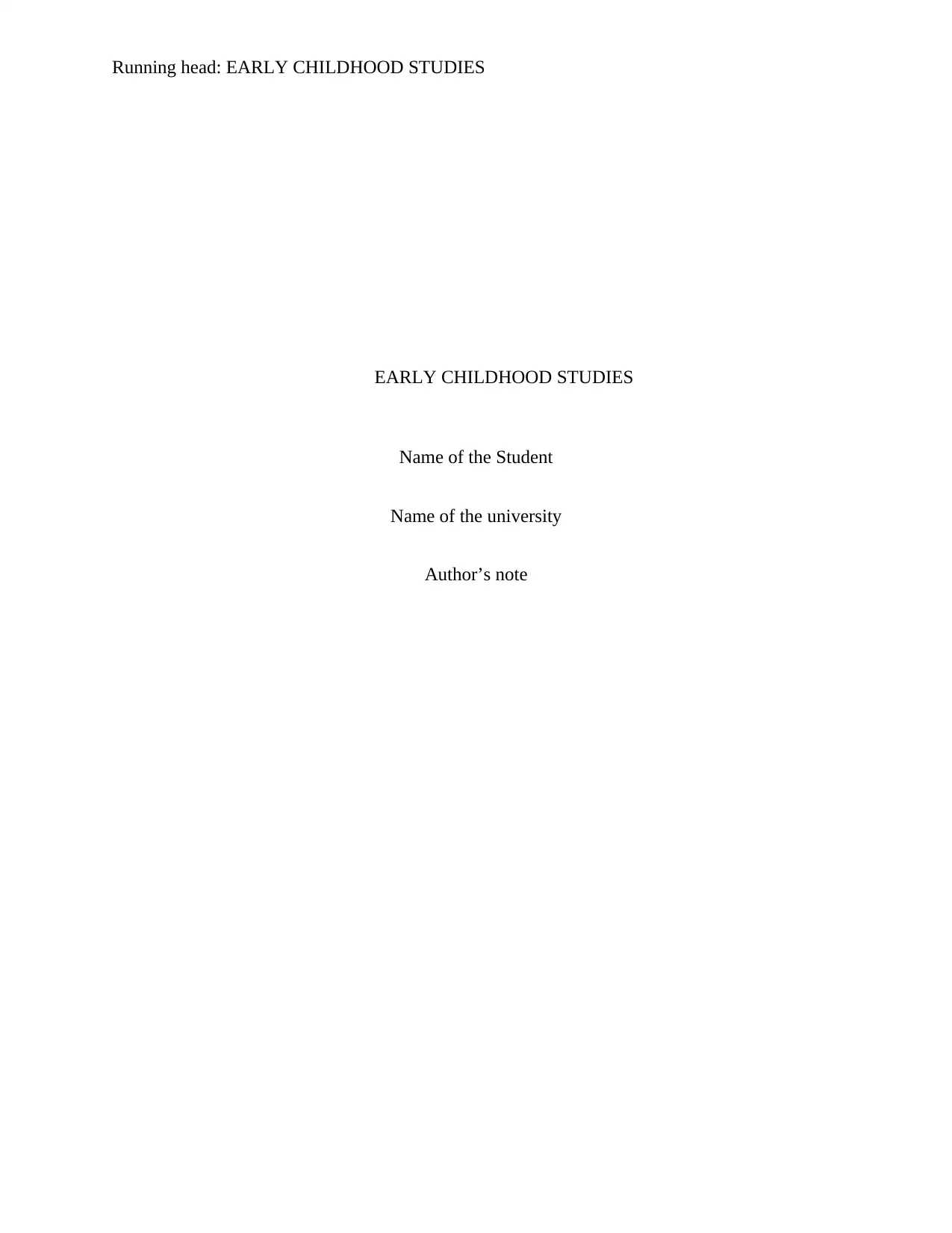
Running head: EARLY CHILDHOOD STUDIES
EARLY CHILDHOOD STUDIES
Name of the Student
Name of the university
Author’s note
EARLY CHILDHOOD STUDIES
Name of the Student
Name of the university
Author’s note
Paraphrase This Document
Need a fresh take? Get an instant paraphrase of this document with our AI Paraphraser
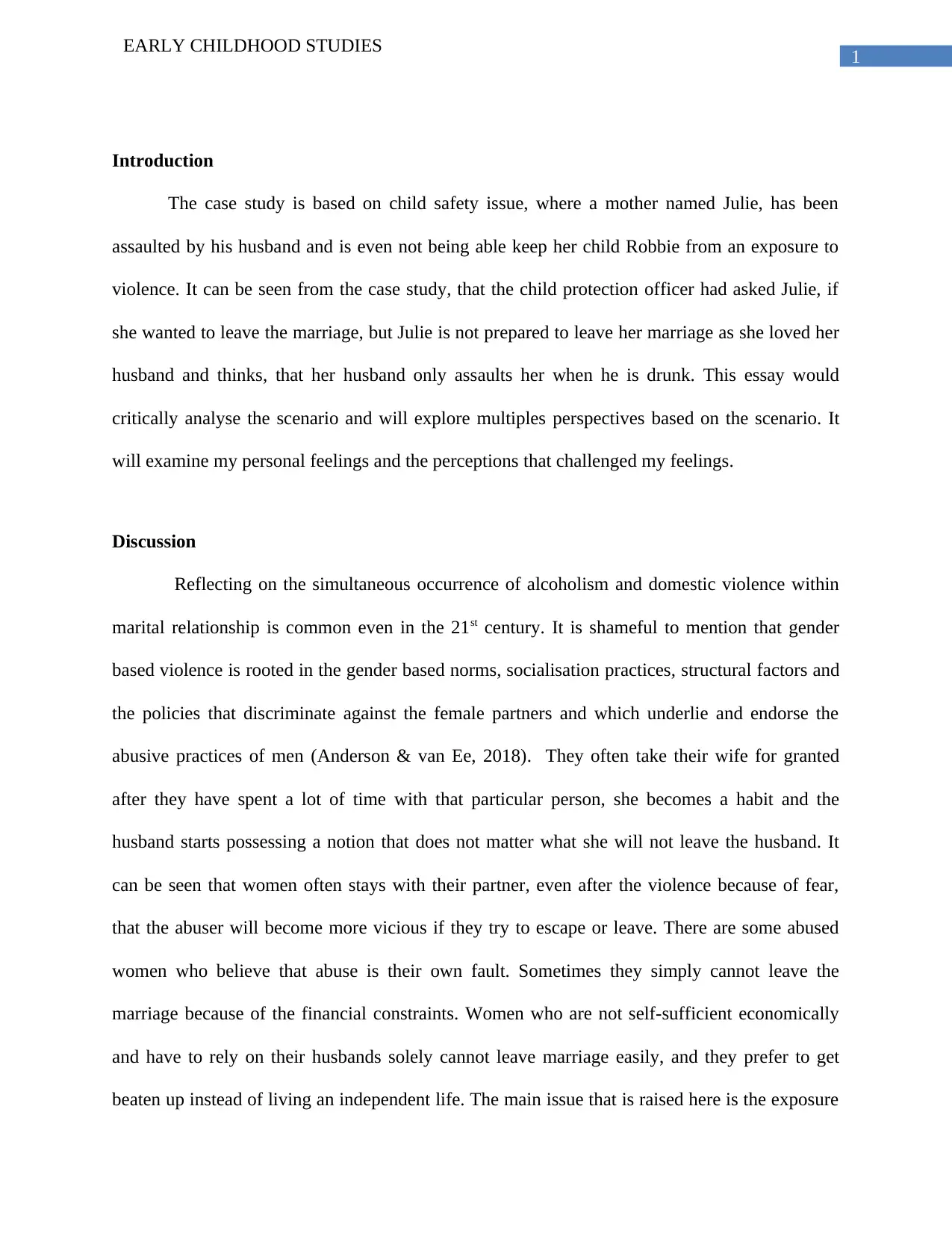
1
EARLY CHILDHOOD STUDIES
Introduction
The case study is based on child safety issue, where a mother named Julie, has been
assaulted by his husband and is even not being able keep her child Robbie from an exposure to
violence. It can be seen from the case study, that the child protection officer had asked Julie, if
she wanted to leave the marriage, but Julie is not prepared to leave her marriage as she loved her
husband and thinks, that her husband only assaults her when he is drunk. This essay would
critically analyse the scenario and will explore multiples perspectives based on the scenario. It
will examine my personal feelings and the perceptions that challenged my feelings.
Discussion
Reflecting on the simultaneous occurrence of alcoholism and domestic violence within
marital relationship is common even in the 21st century. It is shameful to mention that gender
based violence is rooted in the gender based norms, socialisation practices, structural factors and
the policies that discriminate against the female partners and which underlie and endorse the
abusive practices of men (Anderson & van Ee, 2018). They often take their wife for granted
after they have spent a lot of time with that particular person, she becomes a habit and the
husband starts possessing a notion that does not matter what she will not leave the husband. It
can be seen that women often stays with their partner, even after the violence because of fear,
that the abuser will become more vicious if they try to escape or leave. There are some abused
women who believe that abuse is their own fault. Sometimes they simply cannot leave the
marriage because of the financial constraints. Women who are not self-sufficient economically
and have to rely on their husbands solely cannot leave marriage easily, and they prefer to get
beaten up instead of living an independent life. The main issue that is raised here is the exposure
EARLY CHILDHOOD STUDIES
Introduction
The case study is based on child safety issue, where a mother named Julie, has been
assaulted by his husband and is even not being able keep her child Robbie from an exposure to
violence. It can be seen from the case study, that the child protection officer had asked Julie, if
she wanted to leave the marriage, but Julie is not prepared to leave her marriage as she loved her
husband and thinks, that her husband only assaults her when he is drunk. This essay would
critically analyse the scenario and will explore multiples perspectives based on the scenario. It
will examine my personal feelings and the perceptions that challenged my feelings.
Discussion
Reflecting on the simultaneous occurrence of alcoholism and domestic violence within
marital relationship is common even in the 21st century. It is shameful to mention that gender
based violence is rooted in the gender based norms, socialisation practices, structural factors and
the policies that discriminate against the female partners and which underlie and endorse the
abusive practices of men (Anderson & van Ee, 2018). They often take their wife for granted
after they have spent a lot of time with that particular person, she becomes a habit and the
husband starts possessing a notion that does not matter what she will not leave the husband. It
can be seen that women often stays with their partner, even after the violence because of fear,
that the abuser will become more vicious if they try to escape or leave. There are some abused
women who believe that abuse is their own fault. Sometimes they simply cannot leave the
marriage because of the financial constraints. Women who are not self-sufficient economically
and have to rely on their husbands solely cannot leave marriage easily, and they prefer to get
beaten up instead of living an independent life. The main issue that is raised here is the exposure
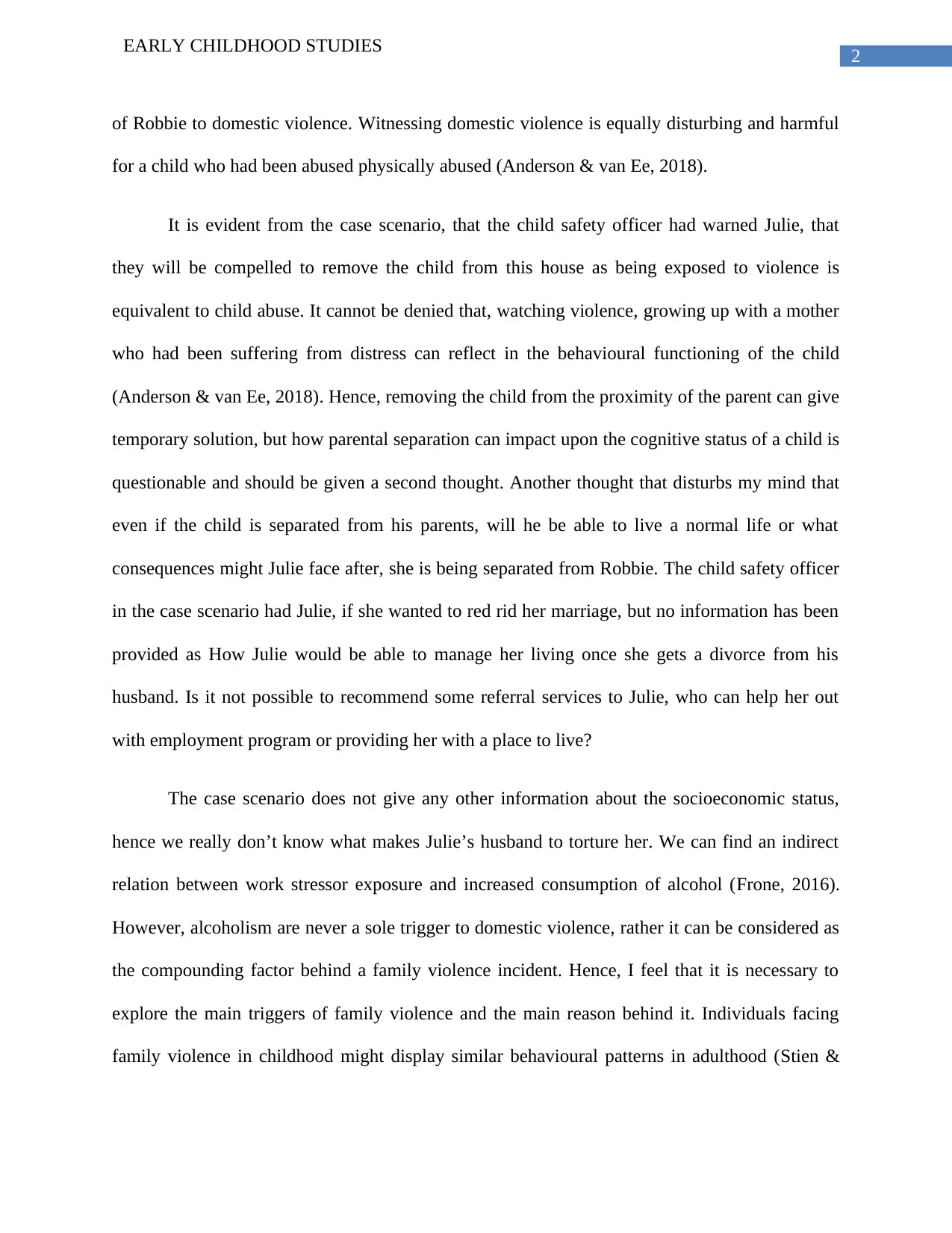
2
EARLY CHILDHOOD STUDIES
of Robbie to domestic violence. Witnessing domestic violence is equally disturbing and harmful
for a child who had been abused physically abused (Anderson & van Ee, 2018).
It is evident from the case scenario, that the child safety officer had warned Julie, that
they will be compelled to remove the child from this house as being exposed to violence is
equivalent to child abuse. It cannot be denied that, watching violence, growing up with a mother
who had been suffering from distress can reflect in the behavioural functioning of the child
(Anderson & van Ee, 2018). Hence, removing the child from the proximity of the parent can give
temporary solution, but how parental separation can impact upon the cognitive status of a child is
questionable and should be given a second thought. Another thought that disturbs my mind that
even if the child is separated from his parents, will he be able to live a normal life or what
consequences might Julie face after, she is being separated from Robbie. The child safety officer
in the case scenario had Julie, if she wanted to red rid her marriage, but no information has been
provided as How Julie would be able to manage her living once she gets a divorce from his
husband. Is it not possible to recommend some referral services to Julie, who can help her out
with employment program or providing her with a place to live?
The case scenario does not give any other information about the socioeconomic status,
hence we really don’t know what makes Julie’s husband to torture her. We can find an indirect
relation between work stressor exposure and increased consumption of alcohol (Frone, 2016).
However, alcoholism are never a sole trigger to domestic violence, rather it can be considered as
the compounding factor behind a family violence incident. Hence, I feel that it is necessary to
explore the main triggers of family violence and the main reason behind it. Individuals facing
family violence in childhood might display similar behavioural patterns in adulthood (Stien &
EARLY CHILDHOOD STUDIES
of Robbie to domestic violence. Witnessing domestic violence is equally disturbing and harmful
for a child who had been abused physically abused (Anderson & van Ee, 2018).
It is evident from the case scenario, that the child safety officer had warned Julie, that
they will be compelled to remove the child from this house as being exposed to violence is
equivalent to child abuse. It cannot be denied that, watching violence, growing up with a mother
who had been suffering from distress can reflect in the behavioural functioning of the child
(Anderson & van Ee, 2018). Hence, removing the child from the proximity of the parent can give
temporary solution, but how parental separation can impact upon the cognitive status of a child is
questionable and should be given a second thought. Another thought that disturbs my mind that
even if the child is separated from his parents, will he be able to live a normal life or what
consequences might Julie face after, she is being separated from Robbie. The child safety officer
in the case scenario had Julie, if she wanted to red rid her marriage, but no information has been
provided as How Julie would be able to manage her living once she gets a divorce from his
husband. Is it not possible to recommend some referral services to Julie, who can help her out
with employment program or providing her with a place to live?
The case scenario does not give any other information about the socioeconomic status,
hence we really don’t know what makes Julie’s husband to torture her. We can find an indirect
relation between work stressor exposure and increased consumption of alcohol (Frone, 2016).
However, alcoholism are never a sole trigger to domestic violence, rather it can be considered as
the compounding factor behind a family violence incident. Hence, I feel that it is necessary to
explore the main triggers of family violence and the main reason behind it. Individuals facing
family violence in childhood might display similar behavioural patterns in adulthood (Stien &
⊘ This is a preview!⊘
Do you want full access?
Subscribe today to unlock all pages.

Trusted by 1+ million students worldwide

3
EARLY CHILDHOOD STUDIES
Kendall, 2014). This section draws on some theories in order to understand this issue
prominently and to develop multiple perspectives on this issue.
The attachment theory can be considered as the best body of researches for understanding
the effects of traumatic separation. According to John Bowlby, who theorised the attachment
theory that children who suffer maternal separation are likely to suffer from both physical and
mental illness, even if they are kept in a well-run institution. It never provides a true maternal
substitute (Holmes, 2014). Mary Ainsworth has went beyond Bowlby and have stated infants
who are securely attached to their parents are more resilient than their peers who are attached
insecurely. It has been found that securely attached children can express their anger freely to
their parents as they do not have the fear that their parents would abandon them.
Parental separation has been found to be liked to an increased livelihood of reporting
psychological distress. Family instability can be a major public health issue among the children
(D'Onofrio & Emery, 2019). Researches have documented that parental separation has been
associated with an increased risk for the child and adolescent adjustment problems, including
performing badly in the academics. It has been found that offspring of divorced or separated
parents are more likely to engage in sexual behaviours and live in poverty and experience the
instability of the families (Holmes, 2014).
Symptoms of depression observed in mothers who had been impacted upon by violence
is associated with the overall value of parenting, which further increases the likelihood of
distress and internalisation of behaviours in the child (Stien & Kendall, 2014). It has been found
that lack of parental warmth and affection is linked with greater dysfunctional behaviour in
children who had been exposed to violence. Parents often act as “emotional anchors” and
EARLY CHILDHOOD STUDIES
Kendall, 2014). This section draws on some theories in order to understand this issue
prominently and to develop multiple perspectives on this issue.
The attachment theory can be considered as the best body of researches for understanding
the effects of traumatic separation. According to John Bowlby, who theorised the attachment
theory that children who suffer maternal separation are likely to suffer from both physical and
mental illness, even if they are kept in a well-run institution. It never provides a true maternal
substitute (Holmes, 2014). Mary Ainsworth has went beyond Bowlby and have stated infants
who are securely attached to their parents are more resilient than their peers who are attached
insecurely. It has been found that securely attached children can express their anger freely to
their parents as they do not have the fear that their parents would abandon them.
Parental separation has been found to be liked to an increased livelihood of reporting
psychological distress. Family instability can be a major public health issue among the children
(D'Onofrio & Emery, 2019). Researches have documented that parental separation has been
associated with an increased risk for the child and adolescent adjustment problems, including
performing badly in the academics. It has been found that offspring of divorced or separated
parents are more likely to engage in sexual behaviours and live in poverty and experience the
instability of the families (Holmes, 2014).
Symptoms of depression observed in mothers who had been impacted upon by violence
is associated with the overall value of parenting, which further increases the likelihood of
distress and internalisation of behaviours in the child (Stien & Kendall, 2014). It has been found
that lack of parental warmth and affection is linked with greater dysfunctional behaviour in
children who had been exposed to violence. Parents often act as “emotional anchors” and
Paraphrase This Document
Need a fresh take? Get an instant paraphrase of this document with our AI Paraphraser
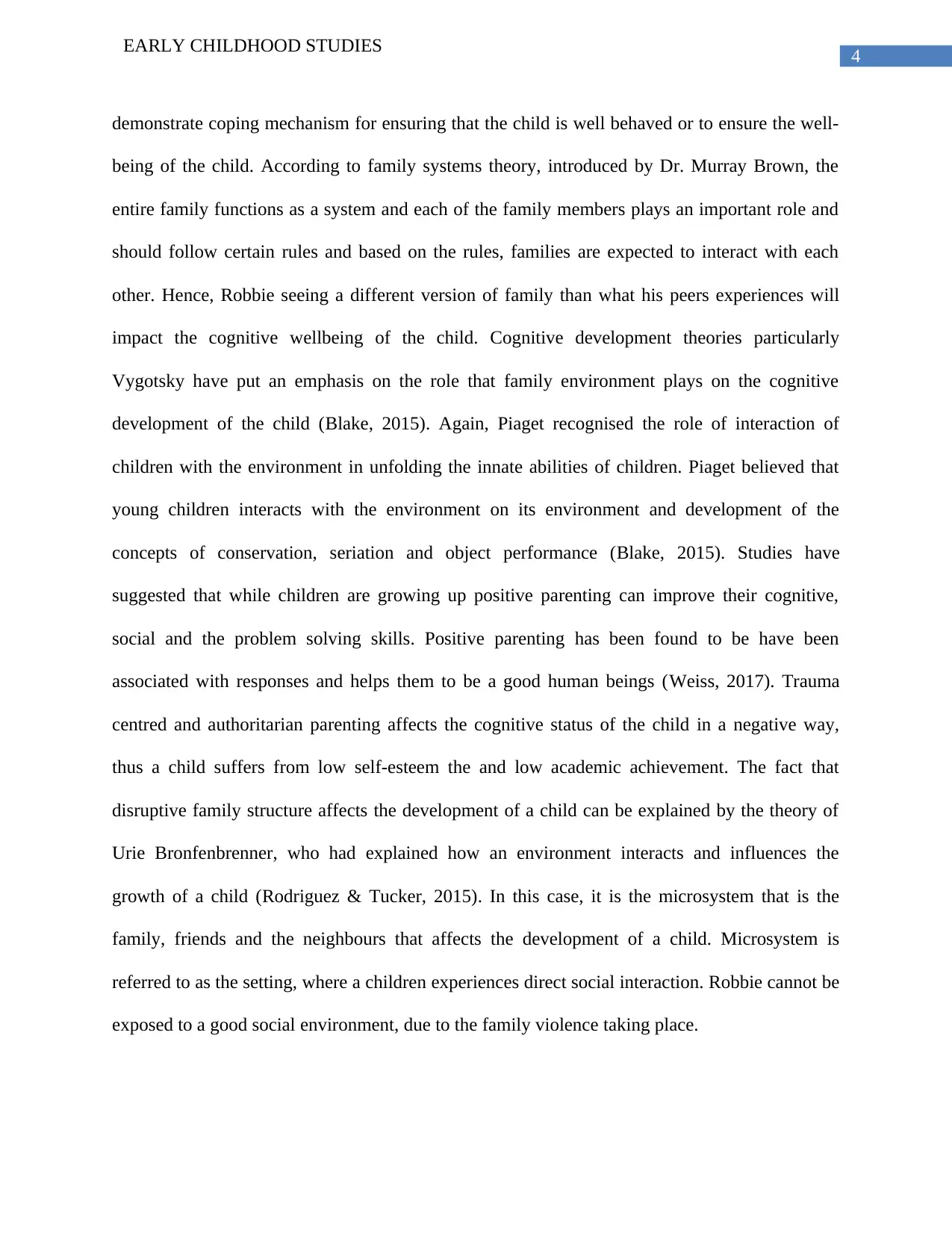
4
EARLY CHILDHOOD STUDIES
demonstrate coping mechanism for ensuring that the child is well behaved or to ensure the well-
being of the child. According to family systems theory, introduced by Dr. Murray Brown, the
entire family functions as a system and each of the family members plays an important role and
should follow certain rules and based on the rules, families are expected to interact with each
other. Hence, Robbie seeing a different version of family than what his peers experiences will
impact the cognitive wellbeing of the child. Cognitive development theories particularly
Vygotsky have put an emphasis on the role that family environment plays on the cognitive
development of the child (Blake, 2015). Again, Piaget recognised the role of interaction of
children with the environment in unfolding the innate abilities of children. Piaget believed that
young children interacts with the environment on its environment and development of the
concepts of conservation, seriation and object performance (Blake, 2015). Studies have
suggested that while children are growing up positive parenting can improve their cognitive,
social and the problem solving skills. Positive parenting has been found to be have been
associated with responses and helps them to be a good human beings (Weiss, 2017). Trauma
centred and authoritarian parenting affects the cognitive status of the child in a negative way,
thus a child suffers from low self-esteem the and low academic achievement. The fact that
disruptive family structure affects the development of a child can be explained by the theory of
Urie Bronfenbrenner, who had explained how an environment interacts and influences the
growth of a child (Rodriguez & Tucker, 2015). In this case, it is the microsystem that is the
family, friends and the neighbours that affects the development of a child. Microsystem is
referred to as the setting, where a children experiences direct social interaction. Robbie cannot be
exposed to a good social environment, due to the family violence taking place.
EARLY CHILDHOOD STUDIES
demonstrate coping mechanism for ensuring that the child is well behaved or to ensure the well-
being of the child. According to family systems theory, introduced by Dr. Murray Brown, the
entire family functions as a system and each of the family members plays an important role and
should follow certain rules and based on the rules, families are expected to interact with each
other. Hence, Robbie seeing a different version of family than what his peers experiences will
impact the cognitive wellbeing of the child. Cognitive development theories particularly
Vygotsky have put an emphasis on the role that family environment plays on the cognitive
development of the child (Blake, 2015). Again, Piaget recognised the role of interaction of
children with the environment in unfolding the innate abilities of children. Piaget believed that
young children interacts with the environment on its environment and development of the
concepts of conservation, seriation and object performance (Blake, 2015). Studies have
suggested that while children are growing up positive parenting can improve their cognitive,
social and the problem solving skills. Positive parenting has been found to be have been
associated with responses and helps them to be a good human beings (Weiss, 2017). Trauma
centred and authoritarian parenting affects the cognitive status of the child in a negative way,
thus a child suffers from low self-esteem the and low academic achievement. The fact that
disruptive family structure affects the development of a child can be explained by the theory of
Urie Bronfenbrenner, who had explained how an environment interacts and influences the
growth of a child (Rodriguez & Tucker, 2015). In this case, it is the microsystem that is the
family, friends and the neighbours that affects the development of a child. Microsystem is
referred to as the setting, where a children experiences direct social interaction. Robbie cannot be
exposed to a good social environment, due to the family violence taking place.

5
EARLY CHILDHOOD STUDIES
While Separation of the child from mother possess threat to the child, but trauma
exposure in young children can be equally concerning. It is evident from the scenario, that
Robbie had been exposed to violence since early years. According to the trauma theory
mentioned in Cook et al, (2017), early exposure to trauma is harmful because the jeopardy of
continuing alterations in the tension related systems and the other brain areas forced at the times
of the sensitive period, as the brain is undergoing some rapid changes and differentiation
(Grasso, Ford & Briggs-Gowan, 2013). Disrupted development in the host can cause an array of
functional deficiencies in the cognitive, behavioural and the personal domains. There are studies
that have proved the relationship between the post traumatic exposure and emotional and
behavioural health problems. Lissek and van Meurs, (2015) have argued that can cause
internalisation and the externalisation behaviour problems later on in the development of the
child. The possible mechanism that can be used for the internalisation of the behavioural
complications in the later growth of a child can be obtained from the stress sensitization theory
or the Kindling theory (Grasso, Ford & Briggs-Gowan, 2013). The theory describes the
procedure by which possible trauma impacts upon the response of an person to the stressors of
life that it takes less strain for precipitating the repetition of the depressive manifestations
(Grasso, Ford & Briggs-Gowan, 2013). This theory is supported by studies showing relation
between child abuse, neglect and the exaggerated responses to a traumatic life events in children
with depression. It has been found from a study by Grasso, Ford & Briggs-Gowan, (2013) that
the adolescents having a background of child abuse and mistreatment reported of a less severe
traumatic event before the commencement of the depressive episodes in comparison to the ones
having no history if maltreatment. Again, in another study, the risk of psychopathology and
EARLY CHILDHOOD STUDIES
While Separation of the child from mother possess threat to the child, but trauma
exposure in young children can be equally concerning. It is evident from the scenario, that
Robbie had been exposed to violence since early years. According to the trauma theory
mentioned in Cook et al, (2017), early exposure to trauma is harmful because the jeopardy of
continuing alterations in the tension related systems and the other brain areas forced at the times
of the sensitive period, as the brain is undergoing some rapid changes and differentiation
(Grasso, Ford & Briggs-Gowan, 2013). Disrupted development in the host can cause an array of
functional deficiencies in the cognitive, behavioural and the personal domains. There are studies
that have proved the relationship between the post traumatic exposure and emotional and
behavioural health problems. Lissek and van Meurs, (2015) have argued that can cause
internalisation and the externalisation behaviour problems later on in the development of the
child. The possible mechanism that can be used for the internalisation of the behavioural
complications in the later growth of a child can be obtained from the stress sensitization theory
or the Kindling theory (Grasso, Ford & Briggs-Gowan, 2013). The theory describes the
procedure by which possible trauma impacts upon the response of an person to the stressors of
life that it takes less strain for precipitating the repetition of the depressive manifestations
(Grasso, Ford & Briggs-Gowan, 2013). This theory is supported by studies showing relation
between child abuse, neglect and the exaggerated responses to a traumatic life events in children
with depression. It has been found from a study by Grasso, Ford & Briggs-Gowan, (2013) that
the adolescents having a background of child abuse and mistreatment reported of a less severe
traumatic event before the commencement of the depressive episodes in comparison to the ones
having no history if maltreatment. Again, in another study, the risk of psychopathology and
⊘ This is a preview!⊘
Do you want full access?
Subscribe today to unlock all pages.

Trusted by 1+ million students worldwide

6
EARLY CHILDHOOD STUDIES
perceived stress due to past year stressful life events was enhanced considerably in the adults
without a history of childhood, physical or emotional abuse.
All these issues have made to believe that mere separation of the child from his parents
and abandoning Julie will not turn in to a good solution. Apart from warning the victim, it is
necessary to believe in her story and then build on her strengths. This helps to identify the
achievements and complement on these. It is necessary to compliment on any coping strategies
that she might take and her problem solving abilities. Most of the women in an abusive
relationship experiences a conflicting feeling towards an abuser (Weiss, 2017). There can be
feelings of anger, love, hate, betrayal, sadness , fear and guilt. It is necessary to make her
understand that these feelings can be reasonable and normal. The immediate safety of the client
should be the first priority of the counsellor. A personal safety plan can be designed for the
patient (Straus & Smith, 2017). Although the victim might be tired of the cycle of violence, steps
has to be taken like providing her with training or employment options, such that she can lead a
new life live on her own. It is evident from the case scenario that the Julie’s husband only
becomes violent, whenever he consumes alcohol. Although alcohol cannot be the sole reason for
domestic violence, but group counselling can be initiated to understand the issue and the
triggering factors.
Conclusion
This paper had analysed the case scenario to the depth and have explored the probable
case like the challenges, that the child will face once he is being removed from his mother
supported by valid theoretical evidences. The written outline has also explored the factors like
the emotional stress and the risk of physical violence that can impact upon the life of the child.
EARLY CHILDHOOD STUDIES
perceived stress due to past year stressful life events was enhanced considerably in the adults
without a history of childhood, physical or emotional abuse.
All these issues have made to believe that mere separation of the child from his parents
and abandoning Julie will not turn in to a good solution. Apart from warning the victim, it is
necessary to believe in her story and then build on her strengths. This helps to identify the
achievements and complement on these. It is necessary to compliment on any coping strategies
that she might take and her problem solving abilities. Most of the women in an abusive
relationship experiences a conflicting feeling towards an abuser (Weiss, 2017). There can be
feelings of anger, love, hate, betrayal, sadness , fear and guilt. It is necessary to make her
understand that these feelings can be reasonable and normal. The immediate safety of the client
should be the first priority of the counsellor. A personal safety plan can be designed for the
patient (Straus & Smith, 2017). Although the victim might be tired of the cycle of violence, steps
has to be taken like providing her with training or employment options, such that she can lead a
new life live on her own. It is evident from the case scenario that the Julie’s husband only
becomes violent, whenever he consumes alcohol. Although alcohol cannot be the sole reason for
domestic violence, but group counselling can be initiated to understand the issue and the
triggering factors.
Conclusion
This paper had analysed the case scenario to the depth and have explored the probable
case like the challenges, that the child will face once he is being removed from his mother
supported by valid theoretical evidences. The written outline has also explored the factors like
the emotional stress and the risk of physical violence that can impact upon the life of the child.
Paraphrase This Document
Need a fresh take? Get an instant paraphrase of this document with our AI Paraphraser

7
EARLY CHILDHOOD STUDIES
Similar factors like the probable reasons for alcoholism and violence in the family has also been
explored. The theories that describes process by which trauma influences the response of an
individual has also been informed. Lastly, few recommendations based on previous researches
have been provided.
EARLY CHILDHOOD STUDIES
Similar factors like the probable reasons for alcoholism and violence in the family has also been
explored. The theories that describes process by which trauma influences the response of an
individual has also been informed. Lastly, few recommendations based on previous researches
have been provided.
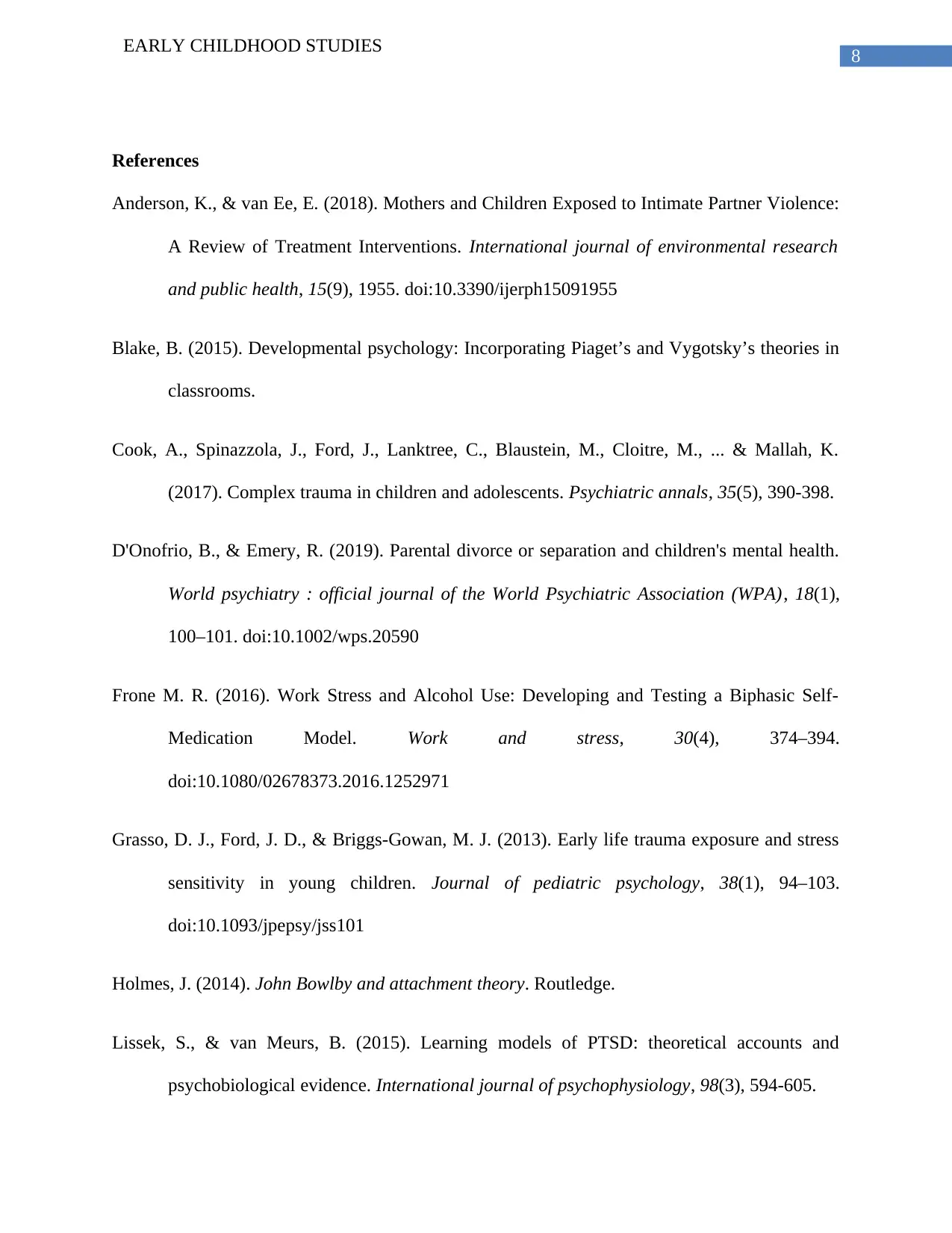
8
EARLY CHILDHOOD STUDIES
References
Anderson, K., & van Ee, E. (2018). Mothers and Children Exposed to Intimate Partner Violence:
A Review of Treatment Interventions. International journal of environmental research
and public health, 15(9), 1955. doi:10.3390/ijerph15091955
Blake, B. (2015). Developmental psychology: Incorporating Piaget’s and Vygotsky’s theories in
classrooms.
Cook, A., Spinazzola, J., Ford, J., Lanktree, C., Blaustein, M., Cloitre, M., ... & Mallah, K.
(2017). Complex trauma in children and adolescents. Psychiatric annals, 35(5), 390-398.
D'Onofrio, B., & Emery, R. (2019). Parental divorce or separation and children's mental health.
World psychiatry : official journal of the World Psychiatric Association (WPA), 18(1),
100–101. doi:10.1002/wps.20590
Frone M. R. (2016). Work Stress and Alcohol Use: Developing and Testing a Biphasic Self-
Medication Model. Work and stress, 30(4), 374–394.
doi:10.1080/02678373.2016.1252971
Grasso, D. J., Ford, J. D., & Briggs-Gowan, M. J. (2013). Early life trauma exposure and stress
sensitivity in young children. Journal of pediatric psychology, 38(1), 94–103.
doi:10.1093/jpepsy/jss101
Holmes, J. (2014). John Bowlby and attachment theory. Routledge.
Lissek, S., & van Meurs, B. (2015). Learning models of PTSD: theoretical accounts and
psychobiological evidence. International journal of psychophysiology, 98(3), 594-605.
EARLY CHILDHOOD STUDIES
References
Anderson, K., & van Ee, E. (2018). Mothers and Children Exposed to Intimate Partner Violence:
A Review of Treatment Interventions. International journal of environmental research
and public health, 15(9), 1955. doi:10.3390/ijerph15091955
Blake, B. (2015). Developmental psychology: Incorporating Piaget’s and Vygotsky’s theories in
classrooms.
Cook, A., Spinazzola, J., Ford, J., Lanktree, C., Blaustein, M., Cloitre, M., ... & Mallah, K.
(2017). Complex trauma in children and adolescents. Psychiatric annals, 35(5), 390-398.
D'Onofrio, B., & Emery, R. (2019). Parental divorce or separation and children's mental health.
World psychiatry : official journal of the World Psychiatric Association (WPA), 18(1),
100–101. doi:10.1002/wps.20590
Frone M. R. (2016). Work Stress and Alcohol Use: Developing and Testing a Biphasic Self-
Medication Model. Work and stress, 30(4), 374–394.
doi:10.1080/02678373.2016.1252971
Grasso, D. J., Ford, J. D., & Briggs-Gowan, M. J. (2013). Early life trauma exposure and stress
sensitivity in young children. Journal of pediatric psychology, 38(1), 94–103.
doi:10.1093/jpepsy/jss101
Holmes, J. (2014). John Bowlby and attachment theory. Routledge.
Lissek, S., & van Meurs, B. (2015). Learning models of PTSD: theoretical accounts and
psychobiological evidence. International journal of psychophysiology, 98(3), 594-605.
⊘ This is a preview!⊘
Do you want full access?
Subscribe today to unlock all pages.

Trusted by 1+ million students worldwide

9
EARLY CHILDHOOD STUDIES
Rodriguez, C. M., & Tucker, M. C. (2015). Predicting maternal physical child abuse risk beyond
distress and social support: Additive role of cognitive processes. Journal of Child and
Family Studies, 24(6), 1780-1790.
Stien, P., & Kendall, J. C. (2014). Psychological trauma and the developing brain:
Neurologically based interventions for troubled children. Routledge.
Straus, M. A., & Smith, C. (2017). Family patterns and primary prevention of family violence. In
Physical violence in American families (pp. 507-526). Routledge.
Weiss, H. B. (2017). Family support and education programs: Working through ecological
theories of human development. In Evaluating family programs (pp. 3-36). Routledge.
EARLY CHILDHOOD STUDIES
Rodriguez, C. M., & Tucker, M. C. (2015). Predicting maternal physical child abuse risk beyond
distress and social support: Additive role of cognitive processes. Journal of Child and
Family Studies, 24(6), 1780-1790.
Stien, P., & Kendall, J. C. (2014). Psychological trauma and the developing brain:
Neurologically based interventions for troubled children. Routledge.
Straus, M. A., & Smith, C. (2017). Family patterns and primary prevention of family violence. In
Physical violence in American families (pp. 507-526). Routledge.
Weiss, H. B. (2017). Family support and education programs: Working through ecological
theories of human development. In Evaluating family programs (pp. 3-36). Routledge.
1 out of 10
Related Documents
Your All-in-One AI-Powered Toolkit for Academic Success.
+13062052269
info@desklib.com
Available 24*7 on WhatsApp / Email
![[object Object]](/_next/static/media/star-bottom.7253800d.svg)
Unlock your academic potential
Copyright © 2020–2025 A2Z Services. All Rights Reserved. Developed and managed by ZUCOL.




